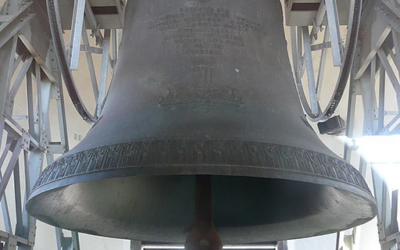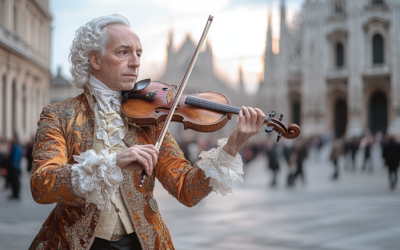Mozart: A Manufactured Miracle
The Questionable Legacy of Niemetschek’s Biography
Franz Xaver Niemetschek’s 1798 Life of the Royal and Imperial Kapellmeister Wolfgang Gottlieb Mozart has been considered the first authentic biography of Mozart. But was it? The Bohemian author’s motivations were far from objective.
His relationship with Mozart’s widow, Constanze, and his ties to the Leipzig publisher Breitkopf & Härtel reveal a hidden agenda. Rather than offering a balanced portrait of Mozart’s life, Niemetschek fashioned an image of a flawless genius to sell Mozart’s works as patriotic relics of the Habsburg Empire.
His narrative has fueled the Mozart myth for over two centuries, paving the way for the profitable “Mozart Inc.” we know today.
Mozart: The Fall of the Gods
This book compiles the results of our studies on 18th-century music and Mozart, who has been revered for over two centuries as a deity. We dismantle the baseless cult of Mozart and strip away the clichés that falsely present him as a natural genius, revealing the contradictions in conventional biographies. In this work, divided into two parts, we identify and critically analyze several contradictory points in the vast Mozart bibliography. Each of the nearly 2,000 citations is meticulously sourced, allowing readers to verify the findings. This critical biography of Mozart emerges from these premises, addressing the numerous doubts raised by researchers.
"The emperor’s clothes are only as resplendent as we choose to believe."
Mozart: The Fall of the Gods
The Illusion of Greatness: Niemetschek’s “Sources”
Franz Xaver Niemetschek, the Bohemian writer and purported biographer of Wolfgang Mozart, holds a peculiar place in history. His 1798 Life of the Royal and Imperial Kapellmeister Wolfgang Gottlieb Mozart has often been hailed as an “authentic” account of the composer. But Niemetschek’s agenda was clear: his work was never intended as an impartial study of Mozart’s life or his compositions. Instead, it functioned as a marketing tool for an emerging Mozart industry that continues to reap profits from the mythical genius it helped construct.
Niemetschek claimed familiarity with Mozart through a fleeting interaction in 1791, yet his biography relies heavily on secondhand stories, many directly from Constanze Mozart. The narrative he constructs is one of a preordained musical hero—a notion crafted more for public consumption than historical accuracy. The portrayal of Mozart as a “natural genius” was convenient for the Leipziger publisher Breitkopf & Härtel, whose Allgemeine musikalische Zeitung (first published in 1798) aimed to boost the sales of Mozart’s works, particularly the Requiem, in what became one of the most lucrative musical ventures of the time.
An “Objective” Biographer, or Constanze’s Confidant?
It’s important to question just how “authentic” Niemetschek’s biography is, considering his close ties to Mozart’s widow, Constanze. Following Mozart’s death, Niemetschek even became a guardian for Mozart’s son Carl Thomas, taking him into his household in Prague. The composer’s legacy, still fresh and vulnerable, was shaped under Niemetschek’s pen, blending anecdotes and glorifying Mozart to foster his image as a patriotic figure of the Habsburg Empire.
Yet, as a writer with direct access to Constanze, Niemetschek had little motivation to critique or provide a balanced assessment of Mozart’s achievements. Instead, he echoed her selective recollections, presenting an image that satisfied the sentimental and patriotic cravings of a Europe that, having subdued the Napoleonic threat, was primed to embrace Mozart as a quasi-national treasure. One wonders how many of these “authentic” sources were curated to portray Mozart as a musical saint, a narrative neatly suited to boosting sales of his works.
Heroism and Hysteria: The Myth of the ‘Divine Genius’
Niemetschek’s biography didn’t simply recount Mozart’s life; it transformed him into a miraculous phenomenon. In his narrative, Mozart was a prodigy whose work emerged fully formed from an otherworldly spark, devoid of human struggle or imperfection. This portrayal is wildly at odds with the letters and historical accounts showing Mozart’s creative process, which often involved a keyboard as an aid for composition. Furthermore, the biography’s pages overflow with florid, heroic language, casting Mozart as a towering, tireless creator—contrary to Leopold Mozart’s frequent chastisement of his son for his disorganization and perceived laziness.
This romanticized narrative has permeated Mozart’s legacy, divorcing him from the realities of his complex, mutable style and from the frustrations he faced. By insisting on an idealized, infallible image, Niemetschek laid the groundwork for what is now a deeply entrenched Mozart mythology—a myth that has blurred our understanding of his real artistic journey. The result was an image so polished, so unreal, that even today it fuels the immense profits of the “Mozart industry.”
Mozart Inc.: The Birth of a Brand
It would be naïve to consider Niemetschek’s biography as merely a labor of admiration. His collaboration with Breitkopf & Härtel ensured a steady stream of Mozart compositions to Leipzig, transforming the composer’s name into a lucrative enterprise. This early “branding” of Mozart—by presenting him as a perfect, timeless genius—allowed for greater commodification, turning his works into assets that transcended mere musical appreciation.
The Mozart myth has since ballooned into a multinational enterprise. Today, “Mozart Inc.” ranks among the top cultural brands worldwide, drawing on the same fabricated stories and hyperbolic anecdotes that Niemetschek pioneered. Far from a historically grounded portrayal, Niemetschek’s Mozart has morphed into a symbol of perfection, whose story is recycled endlessly to sustain an industry based on illusion.
A Legacy of Misinformation
In closing, Niemetschek’s so-called biography is little more than an advertising campaign dressed up as a historical account. Its credibility, propped up by early 19th-century publishers and Mozart’s family, remains largely unchallenged by mainstream musicology, which curiously still references Niemetschek’s work as a reliable source. The enduring grip of this narrative reveals a deep-seated cultural bias, a reluctance to separate fact from fantasy when it comes to cherished icons.
As long as the commercial machinery continues to churn, it seems the Mozart myth will remain untouchable—a testament to the power of narrative over truth. Today, more than ever, we must ask ourselves whether we are content to celebrate an idealized Mozart or if we are ready to scrutinize the legend with the critical eye it deserves. After all, “the emperor’s clothes are only as resplendent as we choose to believe.”
You May Also Like
The Echo of the Pummerin Bell
The powerful resonance of the Pummerin bell in Vienna may have influenced Mozart’s compositions, particularly Sarastro’s arias in The Magic Flute.
The Hidden Influence of Joseph Boulogne, Chevalier de Saint-George
Joseph Boulogne, known as the “Black Mozart”, was shaping the future of music while Mozart was still struggling for recognition in Paris. But history has buried the significant influence Saint-George had on Mozart’s career, erasing his pioneering style from the narrative.
The Forgotten Viennese Quartets
Attributing Offertorium K.34 to Mozart is not just misleading, it reflects the careless methods used by 19th-century scholars to inflate his legacy. Without an autograph or solid evidence, this work should not be considered part of his output.”
Mozart’s Bassoon Concerto: A Question of Authorship
The Bassoon Concerto K.191 raises more questions than it answers. Long thought to have been composed for a Munich bassoonist, new evidence suggests Mozart had no clear performer in mind. The concerto’s disjointed movements and other dubious compositions attributed to Mozart add further complexity to his legacy
The Uncertain Origins of Mozart’s Early String Quartets
Mozart’s so-called “Milanese Quartets” (K.155, 158, and 159) have long been subject to debate, primarily due to their ambiguous instrumentation and structural weaknesses. Were these works part of a larger series of orchestral divertimenti, hastily repurposed as string quartets? The answer remains elusive, reflecting the young composer’s struggles to find his own voice.
Simplicity, Errors, and the Myth of Perfection
Mozart’s canons are not as complex as often claimed, with notable errors in K.553 and K.554, and the myth of “V’amo di cuore teneramente” K.348 being debunked.







